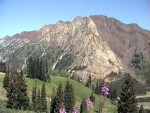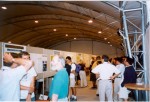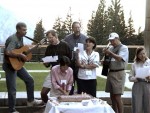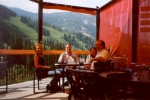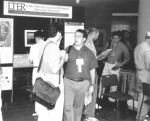Nearly 750 LTER and associated scientists and researchers from 33 countries gathered to exchange ideas, synthesize ongoing projects and foster new research at the 4th LTER All Scientists Meeting at the Snowbird Ski and Summer Resort, located in the Wasatch National Forest of Utah, August 3-5 2000.
The "ASM 2000," themed Long Term Ecological Research: Unifying Principles and Global Applications, filled three days with meetings, workshops, and discussions.
"The Snowbird meeting, like the past two All Scientists Meetings in Colorado, has proved its value in fueling new cross-site initiatives and establishing networking between scientists at the sites," says Bruce Hayden, principal investigator at the Virginia Coast Reserve LTER. "The networking between international colleagues and U.S. LTER scientists at Snowbird was just excellent."
Scott Collins (NSF), Bill Heal, and Jim Gosz laid the foundation for the meeting with discussions of the history and future of the LTER Network from the perspectives of the National Science Foundation, the International LTER Network, and the U.S. LTER Network. Four plenary addresses (by Diana Wall, Indy Burke, Chuck Redman, and Bruce Hayden) focused on major themes of the meeting. Dr. Rosina Bierbaum of the Office of Science and Technology Policy delivered the keynote address titled "Integrated and Interdisciplinary Science Needs: A National Perspective". The program also included a reception for international participants, mixers, poster sessions, a presentation of the new ILTER video, and the first ever LTER Town Meeting. Sixty-six workshops and various ad hoc meetings rounded out the program.
"The ASM was an excellent introduction to the LTER Network and the LTER approach to ecological research," says Dan Childers, principal investigator at the Florida Coastal Everglades (FCE) LTER. "We made numerous connections, and began what will surely prove to be many productive collaborations. Everyone returned from the ASM excited about the opportunities presented by our newly funded LTER program and eager to make an impression on what is a very impressive network of scientists. The ASM experience was particularly meaningful for the students." Childers says the meeting was perfectly timed for a new site. "It is difficult to imagine where we could have learned so much, met so many people, productive collaborations. Everyone returned from the ASM excited about the opportunities presented by our newly funded LTER program and eager to make an impression on what is a very impressive network of scientists. The ASM experience was particularly meaningful for the students." Childers says the meeting was perfectly timed for a new site. "It is difficult to imagine where we could have learned so much, met so many people, and heard so much good science in such a short time."
The meeting immediately preceded the Ecological Society of America annual meeting. Juxtaposing these two gatherings fostered interaction among the LTER community and the broader group of scientists that normally attends the ESA meeting. A large number of non-LTER scientists. Having the two meetings together allowed ESA’s staff to help in the organization and registration tasks for the LTER meeting. In particular, special thanks are due to Ellen Cardwell, ESA’s Meeting Coordinator, as well as Tricia Crocker, Darnell Pinson, Elizabeth Biggs, Frank McDonna, and Nicky Anarado of the ESA Office.
Bob Parmenter of the Sevilleta site and Bob Waide co-chaired the program, and the staff of the LTER Network Office performed the bulk of the organization for the meeting. One of the most exciting aspects of the meeting was the participation of over 100 scientists from existing and aspiring LTER national networks. Thirty-three countries were represented, including all of the existing ILTER networks.
The vigorous participation by international colleagues indicates how far the ILTER network has come since it was founded in 1993. The generous support of the Division of International Programs of NSF contributed to the impressive turnout. On Wednesday night, a reception was held in honor of ILTER scientists. Other activities included a workshop on developing international scientific collaborations organized by Frances Li (NSF) and Ian Simpson (ECN-UK). The ILTER Coordinating Committee meeting was held on Saturday and was followed by an informal hike organized by Bill Chang of NSF. Post-meeting communications indicate the All Scientists Meeting initiated many collaborations between U.S. and International LTER researchers.
The first All Scientists Meeting was held in the mid-1980s. This initial meeting was a team building effort to encourage integration among the LTER sites existing at that time. Subsequent meetings were held in 1990 and 1993. The next ASM is tentatively planned for 2003, and we are soliciting volunteers to form a program committee.


 Enlarge this image
Enlarge this image